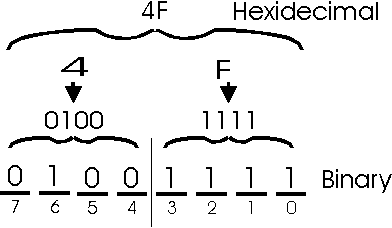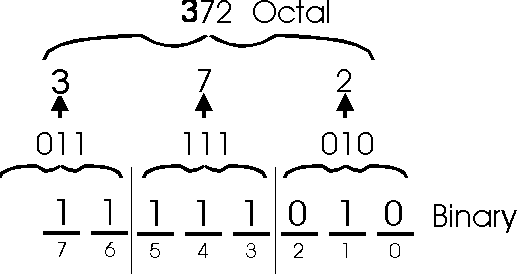

The biggest gripe people have about binary is that it takes so many bit positions to represent even the small numbers. And the biggest gripe people have about decimal is that it is so difficult to convert to binary. The best of both worlds would be to choose a radix which offers a more compact representation of numbers, and is easy to convert to binary. The octal number system, which has a base of 8, is such a system.
Since octal uses base 8, there are 8 digits: 0, 1, 2, 3, 4, 5, 6, 7.
the following table shows the first 16 numbers in decimal, binary, and
octal.
| Binary | Octal | Decimal |
|
0000
|
00
|
0
|
|
0001
|
01
|
1
|
|
0010
|
02
|
2
|
|
0011
|
03
|
3
|
|
0100
|
04
|
4
|
|
0101
|
05
|
5
|
|
0110
|
06
|
6
|
|
0111
|
07
|
7
|
|
1000
|
10
|
8
|
|
1001
|
11
|
9
|
|
1010
|
12
|
10
|
|
1011
|
13
|
11
|
|
1100
|
14
|
12
|
|
1101
|
15
|
13
|
|
1110
|
16
|
14
|
|
1111
|
17
|
15
|
Certainly, we could use our regular conversion methods to convert octal
to decimal. We could successively subtract the largest power of 8, or successively
divide by 8, as we learned in the last
section. But a simple observation about the table above will reveal
an easier method. Here is a hint: whenever there is a carry from the one's
position to the eight's position in the octal number, there is also a carry
from the 4's position to the 8's position in the binary number. Here's
another hint. suppose we "gray out" the 8's position in both the binary
and octal columns, then compare the numbers left over. Maybe you will see
it then...
| Binary | Octal |
|
0000
|
00
|
|
0001
|
01
|
|
0010
|
02
|
|
0011
|
03
|
|
0100
|
04
|
|
0101
|
05
|
|
0110
|
06
|
|
0111
|
07
|
|
1000
|
10
|
|
1001
|
11
|
|
1010
|
12
|
|
1011
|
13
|
|
1100
|
14
|
|
1101
|
15
|
|
1110
|
16
|
|
1111
|
17
|
Converting binary to octal: Counting from right to left, draw a line between every group of 3-bits. The most significant group may not have exactly three bits, so you can just pretend the others are zeros. Now convert each group of three to a single, octal digit. The conversion of a 3-bit number to an octal number is easy. You can memorize the patterns easily and, even if you forget, they are not hard to figure out. The resulting octal digits, when written together in the same order, are the equivalent binary number. Here's an example which converts the binary number '11111010' to its equivalent octal number.

Converting octal to binary: This is simply the reverse of the above process. For every octal digit, just write down the 3-bit pattern that represents it. Here is an example which converts octal number 6252 to binary.
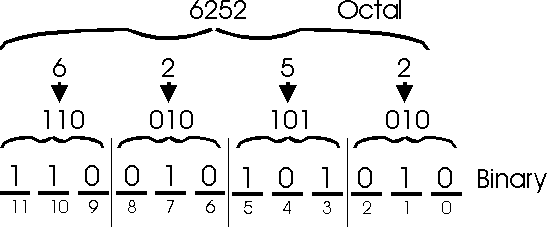
Great! Except there is one slight annoying problem. Remember that modern computers like to group bits together into bytes, so we're going to be working with bytes an awful lot, so we need to be sure that octal is a good idea for use with bytes before we go with it. Let's see how an 8-bit field lines up with our octal conversion.
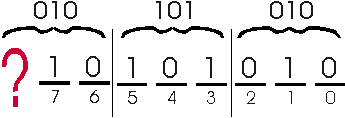
As you can see, for any byte we try to represent, the most-significant octal digit will never exceed the value '3'. Since a byte is 8 bits, and octal digits each represent 3-bits, the third octal digit will never be asked to represent more than 2 bits. That's wasted space, and we don't like wasted space.
So, we now add a third requirement to our list. Here's the list of requirements we want for our new numbering system:
Since this is base 16, there will be 16 digits. Let's count them. 0, 1, 2, 3, 4, 5, 6, 7, 8, 9, ...umm, uh oh.
This is the first base we've encountered that is greater than ten, and
we're used to using only 10 digits: 0 through 9. However, we need 6 more
to have a full set of hexadecimal digits. It may sound strange, but we
will use letters for our other six digits. A, B, C, D, E and F. So, the
full list of hexadecimal digits is: 0, 1, 2, 3, 4, 5, 6, 7, 8, 9, A, B,
C, D, E, F. The hexadecimal digit A is the number 10 in decimal. The hexadecimal
digit F is number 15 in decimal. We now show the table of the first 16
non-negative numbers, with a column added for hexadecimal.
|
Binary
|
Octal
|
Decimal
|
Hexadecimal
|
|
0000
|
00
|
0
|
0
|
|
0001
|
01
|
1
|
1
|
|
0010
|
02
|
2
|
2
|
|
0011
|
03
|
3
|
3
|
|
0100
|
04
|
4
|
4
|
|
0101
|
05
|
5
|
5
|
|
0110
|
06
|
6
|
6
|
|
0111
|
07
|
7
|
7
|
|
1000
|
10
|
8
|
8
|
|
1001
|
11
|
9
|
9
|
|
1010
|
12
|
10
|
A
|
|
1011
|
13
|
11
|
B
|
|
1100
|
14
|
12
|
C
|
|
1101
|
15
|
13
|
D
|
|
1110
|
16
|
14
|
E
|
|
1111
|
17
|
15
|
F
|
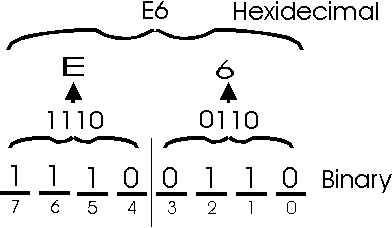
Converting hexadecimal to binary: This is simply the reverse of the above process. For every hexadecimal digit, just write down the 4-bit pattern that represents it. Here is an example which converts hexadecimal number 4F to binary.
